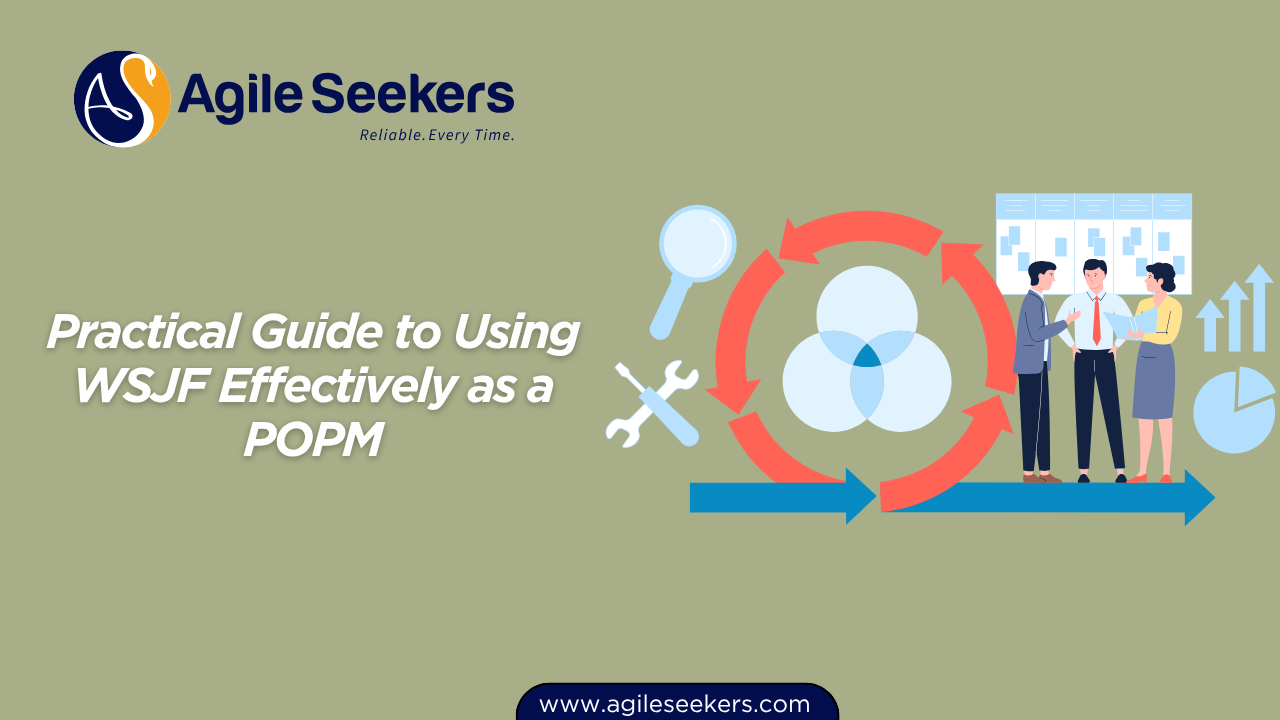Practical Guide to Using WSJF Effectively as a POPM

If you’re working as a Product Owner/Product Manager in a SAFe environment, prioritization isn’t just an activity. It is your core skill. When multiple teams are navigating dependencies and capacity limits, the key question isn’t what needs to be done. It’s what should be done first. WSJF provides a practical way to answer that logically and transparently.
However, most teams only use WSJF at a surface level. They assign numbers, total them up, and treat the result as unquestionable truth. That approach misses the real purpose. WSJF is meant to help teams think more clearly about value and flow. When you understand how to use it correctly, it becomes one of the strongest tools in your prioritization toolkit.
What WSJF Actually Is
WSJF stands for Weighted Shortest Job First. It’s a prioritization model used in SAFe to sequence work based on the highest value delivered in the shortest time.
Formula:
WSJF = Cost of Delay / Job Size
Cost of Delay is calculated by adding:
- Business Value
- Time Criticality
- Risk Reduction or Opportunity Enablement
Job Size represents the effort needed to complete the work.
But here's the thing: WSJF is not just about scoring. It’s about building shared reasoning. This is why learning environments like the POPM certification emphasize value thinking, not just mechanics.
Step 1: Establish Shared Context Before Scoring
Before anyone starts assigning values, ensure the group agrees on:
- The mission of the upcoming PI
- Key drivers such as market changes, customer pressures, and compliance needs
- Dependency awareness across teams
Without context, WSJF becomes personal preference disguised as numbers. Alignment first, scoring second.
Step 2: Break Down Work Before Scoring
Large, vague features skew scoring. To avoid distorted prioritization:
- Clarify the expected user and business outcomes
- Simplify and split work items when necessary
- Ensure the team understands what “done” means conceptually
If two people in the room can’t explain the work item clearly, it’s not ready for WSJF scoring.
Step 3: Score Cost of Delay as a Collaborative Conversation
Business Value
How much impact does the work bring to customers, revenue, or strategic advantage?
Time Criticality
Does delaying this decrease its value? Are there deadlines, renewals, or windows of opportunity?
Risk Reduction / Opportunity Enablement
Does this work remove future obstacles or open new capabilities?
Your role is to facilitate the discussion, not dominate it. Practicing this kind of facilitation is a key part of the SAFe Product Owner and Manager Certification journey.
Step 4: Score Job Size Relatively
Job Size doesn’t need to be an exact effort estimate. It is relative sizing. The question is:
Is this item larger or smaller compared to others on the list?
Use any consistent scale:
- T-shirt sizes
- Story points
- Simple numeric range (1–10)
Consistency matters more than precision.
Step 5: Calculate WSJF and Prioritize
Once scores are assigned, divide Cost of Delay by Job Size and sort highest to lowest. High WSJF means high value delivered quickly.
But remember: WSJF is a decision support tool, not an unbreakable rule. Use the results thoughtfully alongside:
- Technical feasibility
- Dependency constraints
- Organizational commitments
Step 6: Use WSJF Continuously
Don’t treat WSJF as a once-per-PI event. Revisit it during backlog refinement and when new information arrives. Prioritization is continuous, not static.
Step 7: Explain the Prioritization Clearly
People don’t get frustrated because they disagree with priorities. They get frustrated when priorities seem hidden or arbitrary.
Communicate:
- Why certain items are moving forward
- What will wait
- What changed in the reasoning
These communication abilities strengthen naturally through hands-on practice supported by POPM certification Training.
Example: How WSJF Changes Decisions
| Feature | C.o.D | Job Size | WSJF |
|---|---|---|---|
| Customer Dashboard | 14 | 13 | 1.07 |
| API Security Upgrade | 19 | 5 | 3.80 |
The dashboard looks exciting, but the API upgrade delivers higher value per unit of effort. WSJF brings those hidden priorities into the open.
Common Mistakes to Avoid
- Scoring alone instead of collaboratively
- Treating WSJF as a rigid rule instead of a guide
- Using absolute effort estimates rather than relative size
- Ignoring re-evaluation when new information emerges
Make WSJF a Habit
The more consistently WSJF is applied, the more naturally teams learn to think in value flow terms. It helps shift discussions away from personal preferences and toward outcomes that matter.
To deepen your skill in backlog prioritization, stakeholder alignment, and release planning, consider advancing through structured learning programs such as product owner certification.
The real strength of WSJF comes from using it often, discussing it openly, and refining your understanding as your product grows.
Also read - How POPMs Manage and Communicate Program Risks
Also see - The Role of POPMs in Continuous Improvement Culture




















